
The Franklin half dollar is a coin that was struck by the United States Mint from 1948 to 1963. The fifty-cent piece pictures Founding Father Benjamin Franklin on the obverse and the Liberty Bell on the reverse. A small eagle was placed to the right of the bell to fulfill the legal requirement that half dollars depict the figure of an eagle. Produced in 90 percent silver with a reeded edge, the coin was struck at the Philadelphia, Denver, and San Francisco mints.

The Alabama Centennial half dollar, or Alabama half dollar, was a commemorative fifty-cent coin struck by the United States Bureau of the Mint in 1921 as a belated acknowledgement of the 100th anniversary of Alabama's admission to the Union in 1819. The coin was created by Laura Gardin Fraser, the first woman credited with designing a coin.
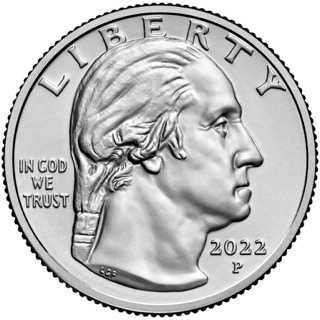
The Washington quarter is the present quarter dollar or 25-cent piece issued by the United States Mint. The coin was first struck in 1932; the original version was designed by sculptor John Flanagan.

The Elgin, Illinois, Centennial half dollar was a fifty-cent commemorative coin issued by the United States Bureau of the Mint in 1936, part of the wave of commemoratives authorized by Congress and struck that year. Intended to commemorate the centennial of the founding of Elgin, the piece was designed by local sculptor Trygve Rovelstad. The obverse depicts an idealized head of a pioneer man. The reverse shows a grouping of pioneers, and is based upon a sculptural group that Rovelstad hoped to build as a memorial to those who settled Illinois, but which was not erected in his lifetime.

The McKinley Birthplace Memorial gold dollar was a commemorative coin struck by the United States Bureau of the Mint in 1916 and 1917, depicting the 25th President of the United States, William McKinley. The coin's obverse was designed by Charles E. Barber, Chief Engraver of the Mint, and the reverse by his assistant, George T. Morgan. As McKinley had appeared on a version of the 1903-dated Louisiana Purchase Exposition dollar, the 1916 release made him the first person to appear on two issues of U.S. coins.

The United States Sesquicentennial coin issue consisted of a commemorative half dollar and quarter eagle struck in 1926 at the Philadelphia Mint for the 150th anniversary of American independence. The obverse of the half dollar features portraits of the first president, George Washington, and the president in 1926, Calvin Coolidge, making it the only American coin to depict a president in his lifetime.
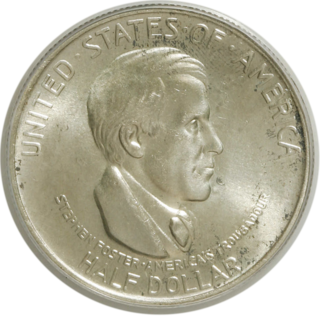
The Cincinnati Musical Center half dollar or Cincinnati Music Center half dollar is a commemorative 50-cent piece struck by the United States Bureau of the Mint in 1936. Produced with the stated purpose of commemorating the fiftieth anniversary of Cincinnati, Ohio, as a center of music, it was conceived by Thomas G. Melish, a coin enthusiast who controlled the group which was allowed to buy the entire issue from the government, and who resold the pieces at high prices.

The five Panama–Pacific commemorative coins were produced in connection with the 1915 Panama–Pacific International Exposition in San Francisco. Struck at that city's mint, the issue included round and octagonal $50 pieces. Excepting modern bullion coins, these two gold pieces are the highest denomination ever issued and the largest coins ever struck by the United States Mint. The octagonal $50 piece is the only U.S. coin to be issued that is not round.
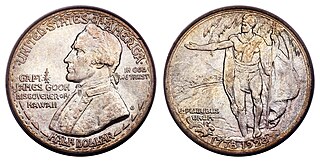
The Hawaii Sesquicentennial half dollar was struck in 1928 by the United States Bureau of the Mint in honor of the 150th anniversary of Captain James Cook's landing in Hawaii, the first European to reach there. The coin depicts Captain Cook on the obverse and a Hawaiian chieftain on the reverse. Only 10,000 were struck for the public, making the coin rare and valuable.

The Fort Vancouver Centennial half dollar, sometimes called the Fort Vancouver half dollar, is a commemorative fifty-cent piece struck by the United States Bureau of the Mint in 1925. The coin was designed by Laura Gardin Fraser. Its obverse depicts John McLoughlin, who was in charge of Fort Vancouver from its construction in 1825 until 1846. From there, he effectively ruled the Oregon Country on behalf of the Hudson's Bay Company. The reverse shows an armed frontiersman standing in front of the fort.

The Vermont Sesquicentennial half dollar, sometimes called the Bennington–Vermont half dollar or the Battle of Bennington Sesquicentennial half dollar, is a commemorative fifty-cent piece struck by the United States Bureau of the Mint in 1927. The coin was designed by Charles Keck, and on its obverse depicts early Vermont leader Ira Allen, brother of Ethan Allen.

The Hudson, New York, Sesquicentennial half dollar, sometimes called the Hudson Sesquicentennial half dollar, is a commemorative fifty-cent piece struck by the United States Bureau of the Mint in 1935. The coin was designed by Chester Beach. Its obverse depicts the Half Moon, flagship of Henry Hudson, after whom the city of Hudson, New York is named. In addition to showing the ship, the coin displays a version of the Hudson city seal, with Neptune riding a whale, a design that has drawn commentary over the years.
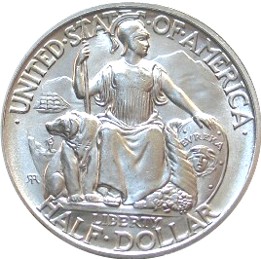
The California Pacific International Exposition half dollar, sometimes called the California Pacific half dollar or the San Diego half dollar, is a commemorative fifty-cent piece struck by the United States Bureau of the Mint in 1935 and 1936. Robert I. Aitken designed the coin. Its obverse depicts Minerva and other elements of the Seal of California; the reverse shows buildings from the California Pacific International Exposition, which the coin was issued to honor.

The Lynchburg Sesquicentennial half dollar was a commemorative half dollar designed by Charles Keck and struck by the United States Bureau of the Mint in 1936, to celebrate the 150th anniversary of the 1786 incorporation of the independent city of Lynchburg, Virginia. The obverse of the coin depicts former Secretary of the Treasury and U.S. Senator Carter Glass, a native of Lynchburg. The reverse depicts a statue of the Goddess of Liberty, with Lynchburg sites behind her, including the Old Courthouse and the city's Confederate monument.

The Columbia, South Carolina, Sesquicentennial half dollar was a commemorative fifty-cent piece struck by the United States Bureau of the Mint. Designed by Abraham Wolfe Davidson and minted in 1936, it marks the 150th anniversary of the designation of Columbia as South Carolina's state capital.
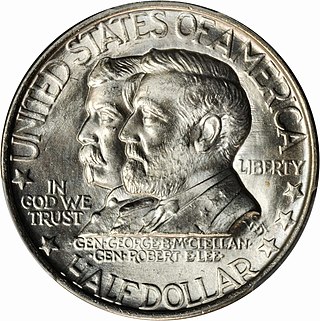
The Battle of Antietam half dollar was designed by William M. Simpson and minted in 1937 to commemorate the 75th anniversary of the Battle of Antietam. The obverse depicts Robert E. Lee and George McClellan, and the reverse shows Burnside's Bridge.

The Illinois Centennial half dollar is a commemorative 50-cent piece struck by the United States Bureau of the Mint in 1918. The obverse, depicting Abraham Lincoln, was designed by Chief Engraver George T. Morgan; the reverse, based on the Seal of Illinois, was by his assistant and successor, John R. Sinnock. Morgan's obverse is based on the statue by Andrew O'Connor.
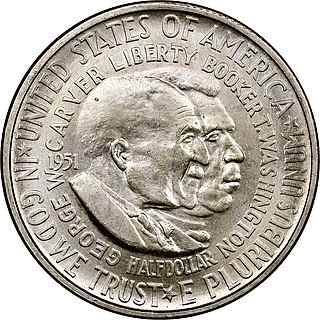
The George Washington Carver-Booker T. Washington Half Dollar was designed by Isaac Scott Hathaway. The obverse depicts side-portraits of George Washington Carver and Booker T. Washington and the reverse shows a simple outline map of the United States of America superimposed with the letters "U.S.A.", and the words "Freedom and Opportunity for All/Americanism" around the rim. It was minted in silver from 1951 until 1954, by authority of Pub. L. 82–151. It was the final issue of early commemoratives.
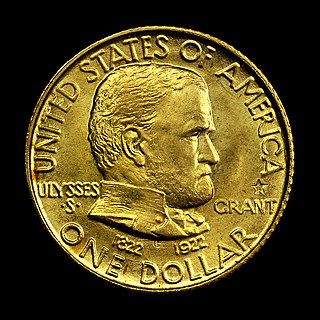
The Grant Memorial coinage are a gold dollar and silver half dollar struck by the United States Bureau of the Mint in 1922 in honor of the 100th anniversary of the birth of Ulysses S. Grant, a leading Union general during the American Civil War and later the 18th president of the United States. The two coins, identical in design and sculpted by Laura Gardin Fraser, portrayed Grant on the obverse and his birthplace in Ohio on the reverse.

The Roanoke Island, North Carolina, half dollar is a commemorative coin issued by the United States Bureau of the Mint in 1937. The coin commemorated the 350th anniversary of the Roanoke Colony, depicting Sir Walter Raleigh on one side, and on the other Eleanor Dare, holding her child, Virginia Dare, the first child of English descent born in an English colony in the Americas.






















